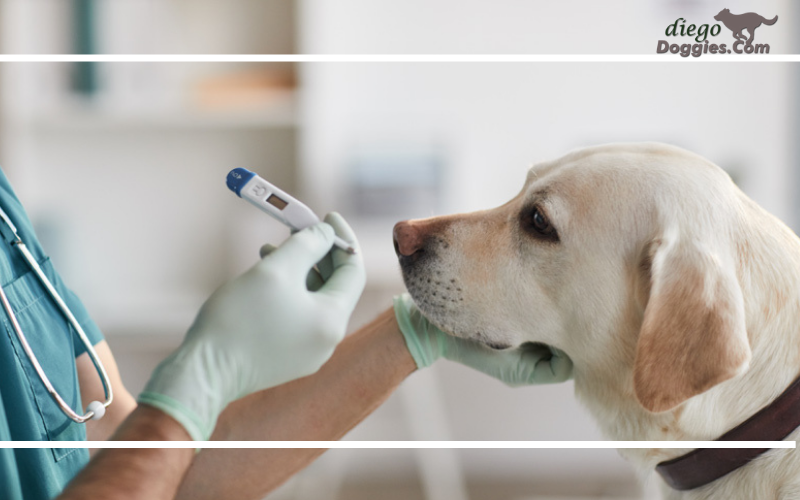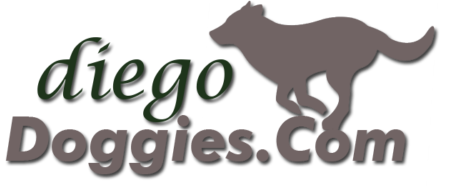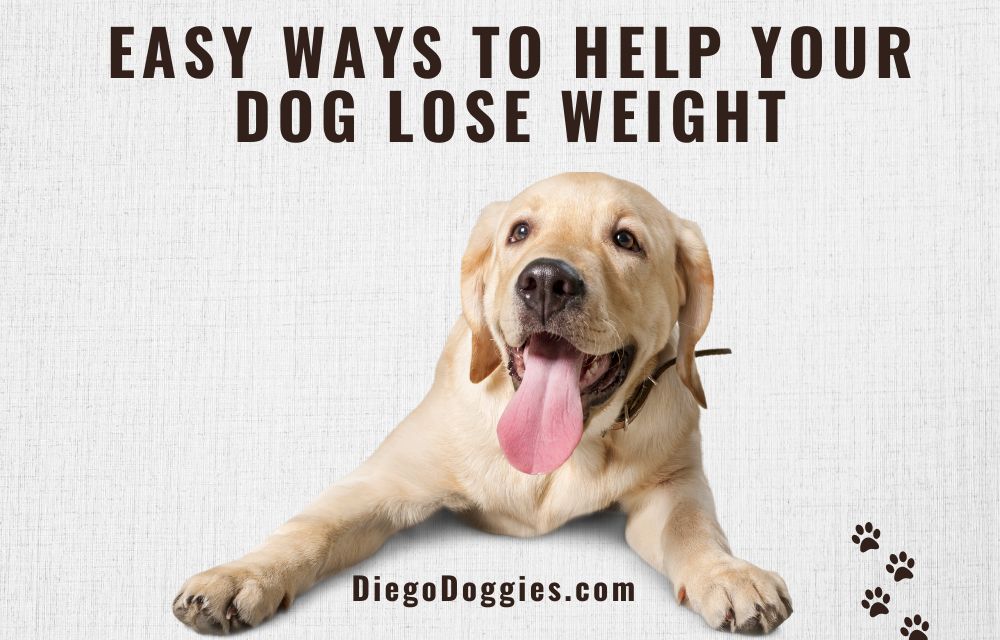Maintaining a healthy weight is essential not just for humans but also for our furry friends. Obesity can lead to various health problems in dogs, including joint, respiratory, and even diabetes. Fortunately, helping your dog lose weight doesn’t have to be a daunting task.
You can help your dog shed those extra pounds and regain a healthy weight with a few simple lifestyle changes. This article will discuss easy ways to help your dog lose weight, including identifying if your dog is overweight, consulting with a veterinarian, monitoring their diet, increasing their exercise, using interactive toys, considering weight loss supplements, and tracking their progress. Following these tips can help your dog lead a happier, healthier life.
Identify If Your Dog Is Overweight
Determining whether they are overweight is the first step in helping your dog lose weight. There are a few ways to do this:
Check their body condition score: This system is used by veterinarians to determine a dog’s ideal weight based on its body shape and size. You can check your dog’s body condition score by feeling its ribs and looking at its waistline. Your dog may be overweight if you can’t feel its ribs, or its waist is not visible.
Weigh your dog: Use a pet scale to weigh your dog and compare it to the recommended weight for their breed and size. If your dog is over 10-20% over their ideal weight, it may be overweight.
Look for signs of obesity: Signs of obesity in dogs include a round belly, lack of energy, and difficulty breathing or moving around.
It’s important to note that if you are unsure if your dog is overweight or has concerns about their health, it’s best to consult a veterinarian. They can perform a complete physical examination and provide more specific recommendations for your dog’s needs.

Consult With a Veterinarian
Before starting any weight loss program for your dog, it’s essential to consult with a veterinarian. They can help you create a weight loss plan tailored to your dog’s needs and ensure that any underlying health conditions are addressed.
During your visit, the veterinarian will perform a physical examination and may recommend blood work to rule out any underlying health issues. They can also help you determine your dog’s ideal weight and provide guidance on how much and what type of food to feed them.
In addition, a veterinarian can recommend an exercise plan appropriate for your dog’s age, breed, and fitness level. They can also suggest specific activities or classes help your dog lose weight and build muscle.
By consulting with a veterinarian, you can ensure that your dog is healthy enough to begin a weight loss program and that their progress is monitored. This will help to ensure that they are losing weight safely and effectively.
Monitor Your Dog’s Diet
Monitoring your dog’s diet is crucial in helping them lose weight. Here are some tips to help you monitor your dog’s diet:
1. Measure their food: Use a measuring cup to ensure that you feed your dog the recommended amount for their size and weight. Avoid free feeding, which means leaving food out all day, as this can lead to overeating.
2. Choose high-quality food: Look for dog food that is high in protein and low in fat. Avoid foods that are high in calories, fillers, and additives.
3. Avoid table scraps: Feeding your dog table scraps can add extra calories to their diet and encourage begging behavior. Instead, please provide them with healthy treats such as carrots, green beans, or apple slices.
4. Consider a weight loss diet: Many weight loss diets are available for dogs that are formulated to help them lose weight safely and effectively. Talk to your veterinarian about whether a weight loss diet is right for your dog.
5. Remember hydration: Make sure your dog has access to clean water. Adequate hydration is essential for overall health and can help with weight loss by promoting a feeling of fullness. By monitoring your dog’s diet, you can ensure they get the nutrition they need to be healthy while also losing weight.
Increase Your Dogs Exercise
Increasing your dog’s exercise is integral to helping them lose weight. Here are some tips to help you improve your dog’s routine:
1. Go for walks: Take your dog for regular walks, starting with short distances and gradually increasing the length and pace. Aim for at least 30 minutes of walking per day.
2. Play fetch: Playing fetch with your dog is a great way to get them moving and burn excess calories. Use a ball or toy your dog loves and take breaks if they get tired.
3. Try swimming: Swimming is a low-impact exercise that can be great for dogs with joint issues. Consider taking your dog to a dog-friendly pool or beach if your dog enjoys swimming.
4. Consider agility training: Agility training involves teaching your dog to navigate obstacles and can be a fun and challenging form of exercise. Look for local classes or create your obstacle course at home.
5. Use a treadmill: If your dog is comfortable using it, it can be a great way to provide regular exercise in any weather. Start with short sessions and gradually increase the time and speed.
Always supervise your dog during exercise and watch for signs of fatigue or discomfort. Increasing your dog’s exercise can help them burn off excess calories and improve their overall health.
Use Interactive Toys
Using interactive toys is another way to help your dog lose weight. Here are some tips to help you incorporate interactive toys into your dog’s exercise routine:
1. Puzzle toys: Puzzle toys are designed to stimulate your dog’s mind and keep them occupied while they work to get a treat. Look for toys that require your dog to manipulate pieces or open compartments to access the pleasure.
2. Interactive balls: Interactive balls are designed to bounce unpredictably, encouraging your dog to run and chase after them. Some interactive balls can be filled with treats to keep your dog motivated.
3. Tug toys: Tug toys can be a fun way to engage with your dog and provide them with exercise. Make sure to choose a tug toy that is durable and appropriate for your dog’s size and strength.
4. Laser pointers: Laser pointers can be a fun way to encourage your dog to run and play. However, it’s essential to avoid shining the laser directly into your dog’s eyes and to monitor their play to prevent overstimulation.
5. Flirt poles: Flirt poles are long sticks with a toy attached to the end. They are designed to mimic the movements of small animals and can be a fun way to engage your dog in play and exercise.
Incorporating interactive toys into your dog’s exercise routine can help keep them engaged and motivated while burning off excess calories. Just make sure to supervise their play and choose toys that are appropriate for their size and strength.
Consider Weight Loss Supplements
Before considering weight loss supplements for your dog, it’s essential to consult with a veterinarian. They can help you determine whether accessories are necessary, and which may be safe and effective for your dog.
Here are some weight loss supplements that may be recommended for dogs:
1. Glucosamine and Chondroitin: These supplements can help improve joint health and mobility in dogs that are overweight or obese. This can make it easier for them to exercise and burn excess calories.
2. Omega-3 Fatty Acids: Omega-3 fatty acids are essential for overall health and can help reduce inflammation and improve skin and coat health. They may also help with weight loss by reducing appetite and improving insulin sensitivity.
3. L-Carnitine: L-Carnitine is an amino acid that helps the body convert fat into energy. It may help dogs burn off excess fat and improve their body composition.
4. Fiber supplements: Fiber supplements can help dogs feel full and reduce their appetite, making it easier for them to lose weight. They may also improve digestive health and regulate blood sugar levels.
Again, it’s essential to consult with a veterinarian before giving your dog any supplements. They can help you determine which supplements may be safe and effective for your dog’s needs and monitor their progress throughout weight loss.
Track Progress And Adjust Accordingly
Tracking your dog’s progress is integral to helping them lose weight. Here are some tips to help you track your dog’s progress and adjust their weight loss plan accordingly:
1. Weigh your dog regularly: Weigh your dog simultaneously each week to track its progress. Please record their weight to see how much they’ve lost over time.
2. Monitor their body condition: Use a scoring system to monitor your dog’s condition. This can help you determine whether they’re at a healthy weight and losing weight appropriately.
3. Adjust their diet and exercise plan as needed: If your dog is losing weight more slowly than you’d like, you may need to adjust their diet or exercise plan. Consult with your veterinarian for guidance on how to make changes safely and effectively.
4. Celebrate milestones: When your dog reaches a weight loss milestone, celebrate their progress with a healthy treat or fun activity. `This can help keep them motivated and reinforce good habits.
5. Stay consistent: Consistency is vital in helping your dog lose weight. Stick to a regular feeding and exercise schedule, and avoid giving in to begging or table scraps.
By tracking your dog’s progress and adjusting as needed, you can help ensure that they continue to lose weight safely and effectively.
Conclusion
Helping your dog lose weight is essential to keeping them healthy and happy. By monitoring their diet, increasing their exercise, using interactive toys, considering weight loss supplements, and tracking their progress, you can help your dog achieve a healthy weight and improve their overall quality of life.
Remember to consult your veterinarian before making any significant changes to your dog’s diet or exercise routine and stay consistent and patient throughout the weight loss process. With dedication and effort, you can help your dog reach their ideal weight and enjoy a long and healthy life together.

